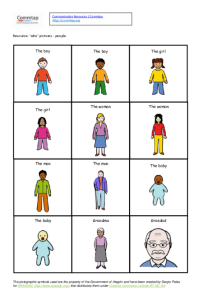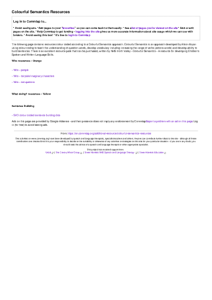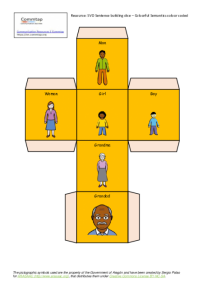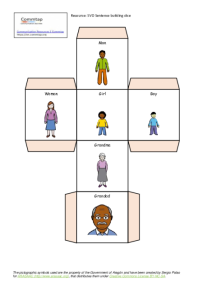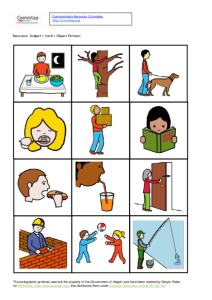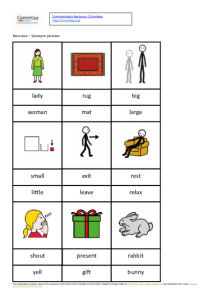Search
User login
Topic “Sentence building”
Colourful Semantics Resources
The following page contains resources colour coded according to a Colourful Semantics approach. Colourful Semantics is an approach developed by Alison Bryan using colour coding to teach the understanding of question words, develop vocabulary including increasing the range of verbs (actions words) and develop ability to build sentences. There is an excellent resource pack that can be purchased, written by NHS Forth Valley - Colourful Semantics - A resource for developing Children's Spoken and Written Language Skills.
Who resources - Orange
- Who - fairytale/imaginary characters
What doing? resources - Yellow
Sentence Building
Activities to develop the use of prepositions 'in', 'on' and 'under' in a short phrase.
| Activity/strategy name and materials required | How to do the activity | Key principles for doing the activity and comments |
|---|---|---|
| Hide the toy - Animal pictures or toys - Toy furniture: table, chair, bed. | 1. Place the furniture in front of the child. 2. Ask the child to tell you what to do with an animal of their choosing if they are able to use three word phrases. If they can only use two word phrases, select the toy for them and ask them to tell you where to put it. e.g. under table / on bed (two word level); cat under table / sheep on bed (three word level)
| Allow the child to explore materials and give time to respond to questions. Respond to however the child manages to get their message across (for example if they just point): you may need to demonstrate what you want the child to do using the appropriate language (e.g. "under (the) table"). After the child is familiar with the objects - you can make the task more difficult (and communicative) by putting a screen between the objects and the child whilst they give you an instruction. |
|
|
write simple sentences
| Activity/strategy name and materials required | How to do the activity | Key principles for doing the activity and comments |
|---|---|---|
| The daily sentence Paper / pencil or pen (and grip if needed) Scissors Story book or picture (optional) (Optional, if available: Clicker grid with the words from the child's sentence in random order. The programme Clicker is available from: www.cricksoft.com.) | 1. Child / adult generate a meaningful sentence orally that is made up of words which are easy to sound out or are high frequency. This could be just 3-4 words to begin with. This could be based on the child's 'news' or a sentence from a book or a sentence based on a picture. 2. Child / adult rehearse the sentence together orally - especially checking that it makes sense. 3. Adult scribes - and writes the words as the child repeats each word slowly. Child watches the adult writing (adult adds capital letter / full stop). 4. Child reads the sentence. Adult ensures child can read all the words. 5. Child writes the sentence without looking at the adult's version. (Adult helps with spellings as appropriate and gives prompts if a word is missing - depending on the needs of the child.) 6. Adult cuts up their (adult's) copy of the sentence into separate words and mixes the words up. 7. Child attempts to re-assemble the sentence. 8. Child reads the re-assembled sentence and checks it makes sense and compares it to the sentence they wrote before. Child makes corrections if any are needed. 9. Child writes a final 'best' copy in a book. | This activity assumes that the child has: basic writing skills e.g. forms letters and can write & spell simple words, can speak in sentences and can identify sentences in reading. It links reading and writing. Focus is on construction of a sentence, so help can be given with spellings where necessary. When repeated every day the adult can reduce the amount of support given gradually (in step 5). Sentences can be gradually extended - simple connectives e.g. 'and' could be added Further activities: Choose a keyword to work on in reading / spelling. Use ICT - use the words from the child's sentence in a Clicker grid - child can work on writing sentences independently by clicking on each word in the correct order. Child could practice writing the sentences to adult's dictation at the end of the week - and compare to sentences made before. Child could take the book of sentences home to practice reading - and draw pictures to illustrate each sentence. |
Activities to develop use the pronoun 'I' to refer to self
| Activity/strategy name and materials required | How to do the activity | Key principles for doing the activity and comments |
|---|---|---|
| Mystery bag of objects - Bag - Different objects | 1. Offer the bag of objects to the child to choose an item. 2. As the child pulls out an object, model the phrase the child needs to use e.g. 'I have got the ...'. 3. You take out an object. Say 'I have got the ...'. 4. You want the child to copy your phrase and use the word 'I'. You may need to tell the child 'Copy my words'. 5. Keep doing this activity until the child can use the standard phrase 'I have got the...'. Reward the child for success with a smile or a sticker. | You could say to the child 'this is a copying game!' Keep the pace up during this activity and keep the phrase you want the child to copy the same each time to make it easier for the child to remember and get it right and so get the reward. |
| Pretend to visit a shop | ||
| Copy the action! |
Activities to develop sentences containing a subject + verb + object
| Activity/strategy name and materials required | How to do the activity | Key principles for doing the activity and comments |
|---|---|---|
| Tea party - Soft toys - Play food and kitchen items - Optional camera | 1. Start by playing with the cutlery and play food. Eat some food yourself and say 'I'm eating banana/ apple/ bread' etc. 2. Let the child play with the food. As he/she eats say 'Sally's eating a banana/ an apple/ some bread' etc. 3. You take photos of the child, you, or the soft toys eating/drinking different items. 4. Print the photo and put it in a book. Show the child the book. Can he/she respond when you ask 'What's happening?' You may need to model the answer for the child for example 'Teddy's eating an apple/ banana/ bread' etc. | Keep language repetitive - emphasize structure It is OK to have silence between repeats of the phrases. If the child makes a sentence and puts the words in the wrong order try to model the correct sentence in a conversational way rather than correcting them (e.g. if they say, 'Teddy apple eat' you say 'Oh, Teddy's eating an apple!'). You are working on the child getting the words in the right order here, don't worry if they miss out endings (like "ing") or small words (like "a"). So the child saying "Teddy eat apple" is fine for this activity. The child may need to hear correct versions of the sentences many times before they are able to use them themselves. Using signs with the key words (e.g. Teddy, apple, eat) can also help the child to develop this skill. |
| Posting | If the child makes a sentence and puts the words in the wrong order try to model the correct sentence in a conversational way rather than correcting them (e.g. if they say, 'She hair brush' you say 'Oh, she's brushing her hair!'). You are working on the child getting the words in the right order here, don't worry if they miss out endings (like "ing") or small words (like "a"). So the child saying "She brush hair" is fine for this activity. The child may need to hear correct versions of the sentences many times before they are able to use them themselves. Using signs with the key words (e.g. she, brush, hair) can also help the child to develop this skill. | |
| Dice Game |
Activities and strategies to develop a student's ability to ask for clarification/help/repetition
| Activity/strategy name and materials required | How to do the activity | Key principles for doing the activity and comments |
|---|---|---|
| Barrier games - 2 identical black and white pictures. - Pens/pencils - A barrier (e.g. a large book) | 1. Play a barrier game:
2. Give a confusing instruction so that the others need to ask for clarification. For example, ask them to colour something that is not on the sheet, to use a colour that is not available. 3. Watch their reaction - if the student lets you know that the instruction is impossible, praise them for this. If the student does not say anything, ask them if there is a problem and talk about hte words that they could use to let you know. | |
| Alien game - Picture of an alien - Some everyday objects |
Building story telling/narrative skills using visual aids
| Activity/strategy name and materials required | How to do the activity | Key principles for doing the activity and comments |
|---|---|---|
| Story Lines - Washing line - Pegs - Selection of pictures | 1. Peg a picture on the line and ask your child to look at it - you could ask you child to choose a picture from a selection. 2. The adult says "It's story time and we are going to make up a story with the pictures" The adult starts the story by using the word on the picture. 3. Encourage your child to take the next turn by choosing a new picture and thinking how they can add to the story that has already been started. 4. Keep going until all the pictures have been used, or the story comes to a natural end. | This activity can be carried out with a small group of children You may need to recap the story at each turn, or give options if your child is finding it challenging to know what they can add. You could use a familiar story and use pictures from the book pegged to the line - you could encourage your child to retell the story with the pictures.
|
| Story Dice | This activity can be carried out with a small group of children You may need to recap the story at each turn, or give options if your child is finding it challenging to know what they can add. |
- « first
- ‹ previous
- 1
- 2
- 3
Support Commtap to keep it online
Thank you for visiting Commtap.
Please read this message as it is extremely important.
- Visitor donations mean we can continue to host over 1,000 free activities to support speech, language, and communication development.
- Visitor donations mean we can continue to provide free resources to address a wide range of communication needs, including limited speech or language, interaction challenges, and needs associated with conditions such as developmental language disorder, autism, and cerebral palsy.
- Visitor donations mean we can continue to provide resources to support the work of speech and language therapists, teachers, teaching assistants, parents, and carers.
- Visitor donations mean we can continue to provide the free key word sign dictionary (bks.org.uk) which has over 2,000 Makaton and Signalong signs.
We know that not everyone is able to afford to pay to access these resources, however, if you can, please make a donation to keep the site going.
Thank you
Google ads on this page are provided by Google Adsense - and their presence does not imply any endorsement by Commtap. Report a problem with an ad on this page. Log in (for free) to avoid seeing Google ads.
